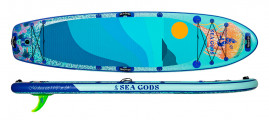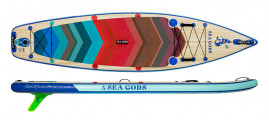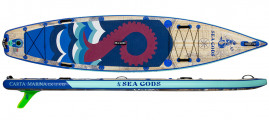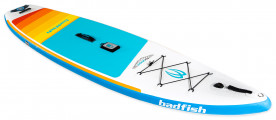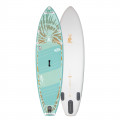The selection of women’s standup paddleboards seems to grow by the day, and with so many choices on the market, this article will help narrow down the options to help you find the best paddleboards for women.
When we say the best standup paddleboard for women, we’re not referring to those paddleboards which are simply a pink or purple remake of a generic model and are marketed as “for women.” We are talking about the actual best suited paddleboards on the market for adventurous moms or cool aunts paddling with kids on board, for women looking to take their fitness on the water or enter a race, and for women who love to SUP with their pup.
We’ll also round up the best paddleboard designs tailored for women who paddle surf, run rapids, enjoy paddleboard camping, paddle out on day trips, relax and enjoy a sunset on their paddleboard, or practice SUP yoga.
Although not all paddleboards are designed with women in mind, with the right information on what to look for, you’ll be able to identify which features and sizing make for the best paddleboards for women. The best standup paddleboard for a woman takes into account her height and weight, her intended use of the paddleboard and any desired features, her strength, and the weight and ease of lifting and carrying the paddleboard. The length, width and volume of the paddleboard, the comfort and placement of the carry handle, and the shaping of the paddleboard all come into play—you deserve to have it all.
It’s also helpful to know what doesn’t work for many women paddleboarders. Here are some of the most common problems with generic standup paddleboards:
- The paddleboard is too long for its intended use
- The paddleboard has too much volume, making it cumbersome on the water
- The paddleboard is too heavy to easily maneuver and load/unload on a vehicle
- The paddleboard is too wide for comfortable paddling and carrying
- The paddleboard carry handle style hurts the fingers during transportation
Steer clear of these issues by choosing a SUP board that fits you and your paddling aspirations. Read on for buying advice for new and used women’s paddleboards, as well as links to reviews and top paddleboards for women.
Top picks: Best paddleboards for women for 2025
The following women’s paddleboards have received the highest star ratings by reviewers in our Paddling Buyer’s Guide. See and review all paddleboards for women here.
Best Womens Paddleboards
Shop women’s paddleboards
From relaxing paddles at the cottage to SUP racing in wind and waves, the waterways are a woman’s playground. It’s important to find the right paddleboard to make your paddling dreams come true. For a comprehensive understanding of what to look for in a women’s paddleboard, scroll down to the Women’s Paddleboard Buying Guide before you start shopping.
When you’re ready to shop, the links below will take you to our Paddling Buyer’s Guide where you can browse every women’s paddleboard on the market, including specifications, prices, reviews and where to buy.
Shop by type
Shop by brand
Shopping for a used women’s paddleboard?
Shopping used is a great way to save some cash on a secondhand women’s paddleboard, but there are some key things to consider when buying a “new to you” SUP for women.
When looking at used boards, don’t allow yourself to get caught up in what is seemingly a great deal without asking, “Is this the right paddleboard for me?” Ask yourself if the paddleboard were new and at a higher price point, would you still consider it? Does it have the appropriate sizing, functionality, features and weight that is best suited for you and your paddling needs, or is it simply appealing at this price?
Similarly, don’t get caught up in flashy graphics or an eye-catching design without considering whether you’ll be happy with the paddleboard’s performance, and if you’ll be able to carry and lift it easily. Before buying a used standup paddleboard, pick up the board to ensure that it is light and comfortable enough to transport.
The last thing you want to do is invest in a board that is hard to move and lift for securing on the top of a vehicle. It is also worth noting how the carry handle feels in your hand when moving the board, as some designs can be really uncomfortable.
The absolute best way to know how a paddleboard feels and performs on the water is to take it for a test paddle. Ask the seller to meet at a location where you can try the board out on the water. Don’t forget to bring a paddle and PFD (unless these are included with the sale) and wear the clothes you plan to paddle in. If a SUP paddle is part of the used package, this is a great added value, but be sure it is sized appropriate to your height and intended use.
For more general tips on what to look for in a used standup paddleboard and how to determine the condition of the used board, read our article How To Buy A Used Paddleboard.
Women’s paddleboard buying guide
Like any outdoor equipment that is advertised as women-specific, some paddleboard manufacturers do a great job of considering real women’s needs and desires, while others simply re-issue generic boards in different colors or graphics. We’ll share what features are better suited to women on average, and how to tell whether a paddleboard is actually appropriate for women or just clever marketing.
As a female standup paddleboard instructor, around 90 percent of my clients are women. Although some of them use women’s standup paddleboards that they love and work well for them, it is also common for women to show up with paddleboards that aren’t exactly the best match. Earlier, I mentioned these common problems with women using ill-suited generic paddleboards:
- The paddleboard is too long for its intended use
- The paddleboard has too much volume, making it cumbersome on the water
- The paddleboard is too heavy to easily maneuver and load/unload on a vehicle
- The paddleboard is too wide for comfortable paddling and carrying
- The paddleboard carry handle style hurts the fingers during transportation
So now that we know what to watch out for, this leads to the question, “What should I look for in a women’s paddleboard?” Consider these guidelines to narrow down the best paddleboards for women.
Appropriate sizing
In North America, the average height of a woman is 5’4” while the average height of a man is 5’9”. On average, North American men also weigh about 30 lbs more than women. Of course, these are just averages and there will be plenty of variation for both men and women, but let’s use these values to better understand paddleboard sizing.
Most paddleboard designs are unisex—in other words, they aren’t targeted to a particular gender. Yet most of these generic paddleboards are designed at the upper limits, with the average height and weight of a man in mind. You can see how a smaller-than-average woman might find herself with an oversized board.
So how do you size appropriately? There is a sweet spot in terms of paddleboard length, recommended weight capacity and volume. Typically, the weight of the paddler is used to determine the required length and volume of the paddleboard. Here is a general guideline for beginners:
| Weight on board | Recommended length |
| Under 150 lbs | 9’6” to 11’ |
| 150–225 lbs | 10’6” to 12’6” |
| Over 225 lbs | 11’6” to 14’ |
The volume of a paddleboard is related to its buoyancy, and therefore its recommended weight capacity. It is important to confirm that you are within the maximum weight capacity of the board and have accounted for additional weight such as kids, dogs or camping gear that you may also carry. You don’t want to be too close to the maximum weight capacity or the paddleboard may feel unstable and sluggish.
Performance will also suffer if you are near the bottom limit of the suggested weight range. Instead, look for a board length and volume that puts your weight mid-range in the “sweet spot” of recommended weight capacity.
For reference, at 5’7” and about 170 lbs I had a challenging time handling a board that was 14 feet long, but really enjoyed paddleboards in the 11’6” to 12’6” range.
Intended use of the paddleboard
There are many different ways to enjoy the water through paddleboarding, which means there are many types of paddleboards, each best suited to their different intended uses.
SUP yoga is a popular and growing activity, especially among women paddleboarders. If the main use of your paddleboard is for SUP yoga, ensure that the board width is at least 32 inches for good stability, and that the deck pad is large and well cushioned. Another handy feature is a place where you can attach an anchor, useful for stationary SUP yoga sessions.
For dog moms who love to SUP with their pup, consider paddleboards with a larger deck pad to enhance your dog’s grip and comfort, as well as to protect the board from their nails.
Women who want to use their paddleboard for distance paddles, camping or day tripping should select a paddleboard with tie-downs for securing snacks, water, outerwear and gear.
Paddleboards that have additional carry handles around the sides, front and back are great for women enjoying quality water time with kids. They can hang onto these carry handles from in the water or use them to help themselves back up on the board after jumping in.
Weight of the paddleboard
Heavier paddleboards can be challenging to carry and lift, especially in windy conditions or in handling more delicate paddleboards. It’s well worth investing a bit more in a board that is lightweight, ideally 25 lbs or less, that you are able to comfortably carry. Consider how far you’ll be carrying your board to the water, and how much weight you can safely manage when lifting the paddleboard on top of your vehicle for transportation.
Width of the paddleboard
While greater width adds stability to a paddleboard, there are two reasons why board width is often an issue for women paddlers.
The first is because in order to paddle straight, the shaft of the paddle must be vertical as the blade enters the water. For shorter women on wider boards, this means reaching their arms uncomfortably far to the side of the board to take an efficient forward stroke. Without this awkward reach, the paddle will enter the water at an angle and the paddleboard will turn rather than travel straight.
The second issue that many women have with wider boards is that they can be difficult to carry. Once again, women who are shorter or have short arms may not be able to easily reach the carry handle in the center of the board. This is often made more tricky when a wide board is also a thick inflatable board.
For these two reasons, it is important to ensure that the width of the board allows for comfortably reaching over the side to put the paddle in the water with a vertical shaft, as well as carrying the paddleboard with relative ease.
Carry handle
The carry handle is an oft-overlooked aspect of the paddleboard that should be noted as a piece of the puzzle that makes up the best women’s paddleboards. Both the location of the carry handle and the style of the handle are important for comfort. “Soapdish”-style handles are recessed within the paddleboard and require you to carry the paddleboard by the tips of your fingers. Grab loop-style carry handles on the deck of the board allow your full hand to wrap around them.
Jodi Bigelow, owner of Ottawa-based Paddlefit, teaches paddleboarding and sells paddleboards to a majority of women clientele. He suggests looking for carry handles that allow the fingers to wrap around and make it easier to carry. “Look for brands that will offset the carry handle off-center,” he adds. “This gives smaller paddlers an option to carry a wider board and not need to have the arm length for a full reach.”
A useful accessory that helps lighten the load of carrying a paddleboard is a shoulder carry strap. Some paddleboards have attachment points along the side where a shoulder carry strap may be fastened to the board.
Visual appeal
You better believe that visual appeal is important for women’s paddleboards. A paddleboard is a big investment and the graphics, design and look of the board go a long way in the enjoyment of your purchase. I bet that if you had a paddleboard with a beautiful design that you love and makes you feel happy, you might even paddle it more often.
If it’s important to you that your board looks super cool or cute, go for it. Enjoy your beautiful board, just make sure that it also performs well. And keep in mind that you can always add aftermarket stickers, graphics and even a colorful new deck pad to spruce up a plain board.
Paddles
It wouldn’t be fair to give you all of the advice on the best women’s standup paddleboards without touching on the best women’s paddles. A quality, correctly sized paddle is every bit as critical to having a positive paddleboarding experience as the board itself.
Don’t invest all of your budget on a paddleboard and then pair it with a big, clunky paddle. Keep a few dollars set aside so that you can upgrade from heavy, entry-level paddles with plastic blades and metal shafts to a lightweight fiberglass or hybrid resin-fiberglass paddle. Your shoulders will thank you.
Adjustable paddles are the best way to go when starting out—they are versatile and can be used by paddlers of different heights by easily adjusting the length. Adjustable paddles also allow you to play around with the paddle length to determine your sweet spot. To determine a rough paddle length, place the tip of the blade on the ground, extend an arm above your head, and adjust the paddle so that the handle hits around your wrist.
Some SUP companies create paddles designed with women in mind, with smaller shafts to suit smaller hand sizes for a more natural and comfortable grip on the paddle. For petite women, a paddle blade size of between 75 and 80 square inches is recommended, while stronger or more aggressive paddlers can use a blade size between 80 and 85 square inches. If a paddle blade is too large, it will be tiring to pull the blade through the water and put a lot of stress on your shoulder.
A note on inflatable paddleboards
For inflatable paddleboards, invest in an electric pump and the appropriate valve adapter, as required. Using a manual hand or foot pump to inflate the board takes about 10 minutes and requires a fair bit of effort and energy. An electric pump will get you on the water faster and easier, and can really improve the paddleboarding experience for all women, but particularly for older women and those with medical conditions which affect strength or energy levels.
Women’s paddleboard reviews
Now that you know what to look for when buying a women’s standup paddleboard, see below for reviews of some of the top models on the market to help in making your decision.
Coming soon




